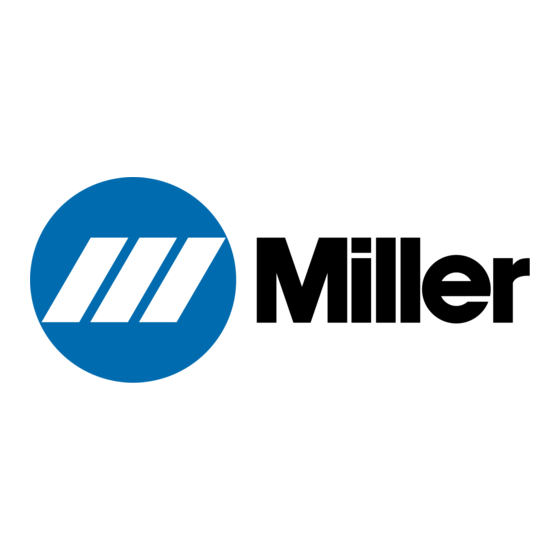Miller TM-268 Manuel technique - Page 4
Parcourez en ligne ou téléchargez le pdf Manuel technique pour {nom_de_la_catégorie} Miller TM-268. Miller TM-268 44 pages.

STEAM AND HOT COOLANT can burn.
D If possible, check coolant level when engine is
cold to avoid scalding.
D Always check coolant level at overflow tank, if
present on unit, instead of radiator.
D If the engine is warm, checking is needed, and there is no overflow
tank, follow the next two statements.
D Wear safety glasses and gloves and put a rag over radiator cap.
D Turn cap slightly and let pressure escape slowly before completely
removing cap.
ELECTRIC AND MAGNETIC FIELDS (EMF)
can affect Implanted Medical Devices.
D Wearers of Pacemakers and other Implanted
Medical Devices should keep away from serv-
icing areas until consulting their doctor and the
device manufacturer.
FALLING EQUIPMENT can injure.
D Use lifting eye to lift unit and properly installed
accessories only, NOT gas cylinders. Do not
exceed maximum lift eye weight rating (see
Specifications).
D Use equipment of adequate capacity to lift and support unit.
D If using lift forks to move unit, be sure forks are long enough to
extend beyond opposite side of unit.
D Follow the guidelines in the Applications Manual for the Revised
NIOSH Lifting Equation (Publication No. 94−110) when manu-
ally lifting heavy parts or equipment.
HOT PARTS can burn.
D Do not touch hot engine parts bare-handed.
D Allow cooling period before working on
equipment.
D
To handle hot parts, use proper tools and/or
wear heavy, insulated welding gloves and
clothing to prevent burns.
TILTING OR TIPPING can injure.
D Do not put any body part under unit while lifting.
D Always use proper equipment (hoists, slings,
chains, blocks, etc.) of adequate capacity to lift
and support components (stator, rotor, engine,
etc.) as needed during job.
PINCH POINTS can injure.
D Be careful when working on stator and rotor assemblies.
EXPLODING PARTS can injure.
D Failed parts can explode or cause other parts to
explode when power is applied to inverters.
D Always wear a face shield and long sleeves
when servicing inverters.
H.F. RADIATION can cause interference.
D High-frequency (H.F.) can interfere with radio
navigation, safety services, computers, and
communications equipment.
D Have only qualified persons familiar with elec-
tronic equipment perform this installation.
D The user is responsible for having a qualified electrician promptly
correct any interference problem resulting from the installation.
D If notified by the FCC about interference, stop using the equipment
at once.
TM-268 819 Page 2
D Have the installation regularly checked and maintained.
D Keep high-frequency source doors and panels tightly shut, keep
spark gaps at correct setting, and use grounding and shielding to
minimize the possibility of interference.
OVERUSE can cause OVERHEATING.
D Allow cooling period; follow rated duty cycle.
D Reduce current or reduce duty cycle before
starting to weld again.
D Do not block or filter airflow to unit.
SHOCK HAZARD from testing.
D Stop engine or turn Off welding power source (if
applicable) before making or changing meter
lead connections.
D Use at least one meter lead that has a self-
retaining spring clip such as an alligator clip.
D Read instructions for test equipment.
READ INSTRUCTIONS.
D Use Testing Booklet (Part No. 150 853) when
servicing this unit.
D Consult the Owner's Manual for welding safety
precautions.
D Use only genuine replacement parts from the manufacturer.
D Read and follow all labels and the Technical Manual carefully be-
fore installing, operating, or servicing unit. Read the safety in-
formation at the beginning of the manual and in each section.
D Perform maintenance and service according to the Technical
Manual, industry standards, and national, state, and local codes.
D Reinstall injectors and bleed air from fuel system according to
engine manual.
HYDRAULIC EQUIPMENT can injure
or kill.
D Before working on hydraulic system, turn off
and lockout/tagout unit, release pressure, and
be sure hydraulic pressure cannot be accident-
ally applied.
D Do not work on hydraulic system with unit running unless you are a
qualified person and following the manufacturer's instructions.
D Do not modify or alter hydraulic pump or manufacturer-supplied
equipment. Do not disconnect, disable, or override any safety
equipment in the hydraulic system.
D Keep away from potential pinch points or crush points created by
equipment connected to the hydraulic system.
D Do not work under or around any equipment that is supported only
by hydraulic pressure. Properly support equipment by mechanical
means.
HYDRAULIC FLUID can injure or kill.
D Before working on hydraulic system, turn off and
lockout/tagout unit, release pressure, and be sure
hydraulic pressure cannot be accidentally applied.
D Relieve pressure before disconnecting or con-
necting hydraulic lines.
D Check hydraulic system components and all con-
nections and hoses for damage, leaks, and wear
before operating unit.
D Wear protective equipment such as safety
glasses, leather gloves, heavy shirt and trousers,
high shoes, and a cap when working on hydraulic
system.
D Use a piece of paper or cardboard to search for
leaks−−never use bare hands. Do not use equip-
ment if leaks are found.
Belt Drive Generator
